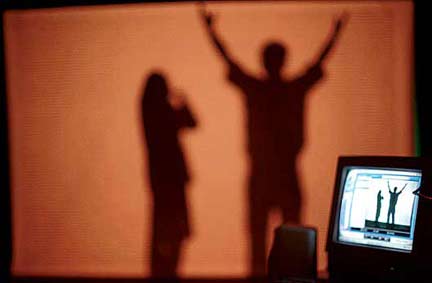| In a world in which information is boundless, we are able to publish our works digitally and make them accessible to every one regardless of their physical location.
"A website is not only a place to introduce an art work, but a contemporary way of conveying ideas and art." Nadalian
WWWebArt.Com displays the works of contemporary artist, Dr. A. Nadalian. His work covers a variety of techniques: online art, interactive art, web animation , web installation and web performances. He has also presented his concepts in environmental art, ritual performances , body art, videos , animations and multimedia arts.
Virtual World
Today, during the communication age, a new dialogue is taking place and we can see the process of a global culture in motion. Nothing epitomizes contemporary life better than the computer. For better or worse, computers have infiltrated every aspect of our society. Today computers do much more than save data. We are living in a new age, one in which has its unique culture and arts. The development of new media and electronic tools has resulted in a global culture. With the arrival of the Internet a new window has opened from which we can see the minds and ideas of different people from different cultures.
The Internet was first conceived in the early '60s but it was not until the 90’s that it fully developed. Within 30 years, the Internet has grown from a Cold War concept for controlling the tattered remains of a post-nuclear society to the Information Superhighway. Just as the railroads of the 19th century enabled the Machine Age and revolutionized the society of that time, the Internet takes us into the Information Age and profoundly affects the world in which we live.
Today people everywhere use the Internet. As a new generation grows up as accustomed to communicating through a keyboard as they do in person, the Internet will become an increasingly important part of life on Earth.
Although the Internet connects more than 10 million hosts worldwide, currently the Internet Society, the group that controls the INTERNET, is trying to figure out new TCP/IP to be able to have billions of addresses.
In a world in which information has no border, we are able to publish our works digitally and make them accessible to every one regardless of their physical location.
Through the use of satellite systems, international signals can be received in any part of the world. This technology has given us access to and enabled us to see the arts and cultures of different people through their television programming. The advances in cellular technology enable us to converse with one another, send or receive e-mail and more recently, transmit pictorial data.
Displaying our works on the Internet makes possible their viewing by any person around the world. This virtual exhibition can provide the opportunity for valuable feedback. This way of communication is fast and readily lends itself to the ever changing and increasing sources of information.
To fully understand the impact of the communication age on our lives and arts, it is important to see both its positive and negative aspects. The general problem is that there are still many around the world that do not have access to this technology. Although the world is said to be a global village, however, there are still things in this village that have not yet been seen by any satellite or read about on any Internet site. Even if these things have been discovered, they may not be fully understood or comprehended. Not all sources of information are interactive and as a result some cultures are the producers and others the consumers.
Even though the Internet provides us with the means to chat and communicate with many individuals, it does not offer us complete information on who they are. This way of communication has replaced personal and intimate forms of correspondence between humans. Direct contact with other humans, makes us realize more clearly who they are. When we meet and live with people, we have the choice to see in them characteristics that may otherwise be concealed had we only communicated with them through the Internet.
People need to physically meet each other. They must engage in their usual manner of physical interactions such as shaking hands or kissing cheeks when saying hello. As artists, we need to exchange ideas and thoughts with each other. It is always very satisfying to know that we really do speak a universal language through our art and that the world becomes much smaller and more intimately connected through this very human act of making art.
What does global culture or village mean? It still seems too early to say that a global culture means all local cultures combined into a single one. It might be safer to say that a global culture has brought unity of thought on many issues around the world. Most people, regardless of their country of residence, share the same concerns and tackle similar everyday problems.
We are living in an age when pluralism and multi-cultural ideas are not only acceptable, but are warmly welcomed. What is no longer recommended or even tolerated is ethnocentricity. There is no creativity or progress in imitation whether intentional or not or out of ignorance. In the contemporary world we need both local and international cultures.
As similar as we are, humans are separated by cultural gaps and in order to find a common thread that ties us together, we need to focus on the links that connect us to one another.
Despite all problems which prevent to achieve these goals, be they economic or political, we need to know more about each other. This will help us understand and tolerate each other. Dialogue between cultures can have a symbiotic effect and guarantee peace.
Through dialogue we can enrich our culture, create a new and improved international one.
Contact:
Cellular Telephone:
WWWebArt.Com -2003 © All rights reserved
[email protected]
|
![]()






